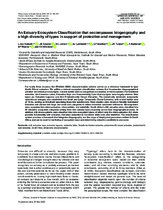| dc.contributor.author | Rajkaran, Anusha | |
| dc.contributor.author | van Niekerk, Lara | |
| dc.contributor.author | Adams, Janine B. | |
| dc.date.accessioned | 2021-01-21T10:42:46Z | |
| dc.date.available | 2021-01-21T10:42:46Z | |
| dc.date.issued | 2020 | |
| dc.identifier.citation | Rajkaran, A. et al. (2020). An estuary ecosystem classification that encompasses biogeography and a high diversity of types in support of protection and management. African Journal of Aquatic Science, 45(1-2), 199-216 | en_US |
| dc.identifier.issn | 1727-9364 | |
| dc.identifier.uri | 10.2989/16085914.2019.1685934 | |
| dc.identifier.uri | http://hdl.handle.net/10566/5717 | |
| dc.description.abstract | For nearly three decades, the Whitfield (1992) characterisation scheme served as a reference framework to type South African estuaries. We outline a revised ecosystem classification scheme that incorporates biogeographical zonation and introduces new types. Coastal outlets were re-categorised as estuaries or micro-systems. For functional estuaries, the Estuarine Lakes, Estuarine Bays and Predominantly Open Estuary types were largely retained. New types are Estuarine Lagoons and Arid Predominantly Closed Estuaries. The numerically dominant, temporarily open/closed category was subdivided into Small and Large Temporarily Closed Estuaries, with a total habitat area of 15 ha, serving as threshold separating these two subdivisions. River mouths were renamed Fluvially Dominated Estuaries and divided into large and small size categories to reflect dissimilar catchment influences. Micro-systems were separated into micro-estuaries, micro-outlets, and waterfalls. South Africa’s 290 estuaries were classified into 22 estuarine ecosystem categories arising from nine estuary types occurring across four biogeographical zones. | en_US |
| dc.language.iso | en | en_US |
| dc.publisher | Taylor & Francis | en_US |
| dc.subject | Estuarine bays | en_US |
| dc.subject | Estuarine lagoons | en_US |
| dc.subject | Fluvially dominated estuaries | en_US |
| dc.subject | Predominantly closed estuaries | en_US |
| dc.subject | South Africa | en_US |
| dc.title | An estuary ecosystem classification that encompasses biogeography and a high diversity of types in support of protection and management | en_US |
| dc.type | Article | en_US |

